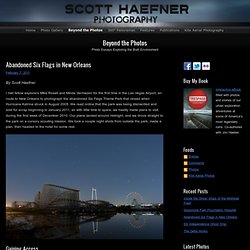

Top 10 Links of the Week (Part 19): Urban Art & Abandoned Places. (Image: Alf Gillman, reproduced with permission – seen previously on Urban Ghosts) Welcome to the 19th edition of our weekly link round-up, showcasing a selection of awesome articles from our friends, partners and sites we like around the web.

This week’s edition looks at a range of interesting finds from urban and recycled art to naturally occurring fractal patterns, creepy abandoned leper colonies and forgotten theatres. The Abandoned Hulme Hippodrome Theatre, Manchester (Skyliner) New York City’s Eerie Abandoned Leper Colony (Mail Online) The Fractal Patterns of Landscapes Devastated by Drought (Environmental Graffiti) Abandoned Boats, Ships and Docks (WebUrbanist) Crashed B-17 Bomber, Papua New Guinea (Flickr) Monkdogz Urban Art Gallery, New York City (Monkdogz) NYC Subway: Redbirds Underwater (Urbanartcore.eu) China's Abandoned Wonderland. In Chenzhuang Village, China, about 20 miles northwest of central Beijing, the ruins of a partially built amusement park called Wonderland sit near a highway, surrounded by houses and fields of corn.

Construction work at the park, which developers had promised would be "the largest amusement park in Asia," stopped around 1998 after disagreements with the local government and farmers over property prices. Developers briefly tried to restart construction in 2008, but without success. The abandoned structures are now a draw for local children and a few photographers, who encounter signs telling them to proceed at their own risk. Reuters photographer David Gray visited the site on a chilly morning earlier this month and returned with these haunting images of a would-be Wonderland. [21 photos] Use j/k keys or ←/→ to navigate Choose: Footsteps in fresh snow are seen across a walkway leading to the entrance of Wonderland, a derelict amusement park northwest of Beijing, on December 5, 2011. Abandoned Six Flags in New Orleans.
I met fellow explorers Mike Rosati and Minda Vermazen for the first time in the Las Vegas Airport, en route to New Orleans to photograph the abandoned Six Flags Theme Park that closed when Hurricane Katrina struck in August 2005.

We read online that the park was being dismantled and sold for scrap beginning in January 2011, so with little time to spare, we hastily made plans to visit during the first week of December 2010. Our plane landed around midnight, and we drove straight to the park on a cursory scouting mission. We took a couple night shots from outside the park, made a plan, then headed to the hotel for some rest. Gaining Access The next day, we spent 10 hours documenting and exploring the park. We entered through a hole in a barbed-wire fence along a main thoroughfare, right next to a Six Flags sign that still reads “Closed for Storm” a full five plus years after Hurricane Katrina ravaged the city. History and Geography Exploring the Park The Future Wrapping Up. Abandoned places. The world's ten creepiest abandoned cities. 100 Abandoned Houses on Photography Served.
8 Abandoned American Theme Parks “Open” for Exploration. Amusement parks walk the fine line between fun-ish and semi-creepy. Maybe it’s the combination of sketchy rides, circus folk, questionable attractions, and way too many screaming kids, but there’s something a little unsettling about them. Add an ill-advised theme into the mix, and you’ve got a real summer-time winner. Although for most of the 20th century amusement parks were a staple of American culture, the shine is definitely off the bumper car.
Tons of new parks litter the country, but many of the old classics, unable to compete with the snazzy new parks, have been shut down. Most have been destroyed to make way for housing developments and malls, but a few still remain. But be warned urban explorer! The Prehistoric Forest, Irish Hills, Michigan Imagine Jurassic Park, but instead of real, blood-thirsty-Jeep-munching dinos you get dilapidated, stationary dinosaur statues situated around a mediocre community pool. [All Dinosaur Images: RoadsideArchitecture via Debra Jane Seltzer]